SPH10002 - Sport Science: Athlete Training, Nutrition & Exercise
VerifiedAdded on 2023/06/07
|8
|1643
|447
Report
AI Summary
This report delves into the realm of sports science, examining how exercise and nutrition impact athlete effectiveness. It emphasizes the importance of a balanced diet and exercise regimen for optimal performance and overall health. The report includes an assessment of an athlete's physical condition before and after a training period, highlighting improvements in posture, flexibility, and endurance. A detailed three-week training program is outlined, incorporating various exercises to enhance strength and conditioning. Furthermore, a comprehensive nutrition plan is provided, offering meal suggestions for each day of the week. The report concludes by underscoring the equal contribution of diet and exercise to an athlete's fitness, advocating for a holistic approach to training and well-being. Desklib provides access to similar assignments and study resources for students.
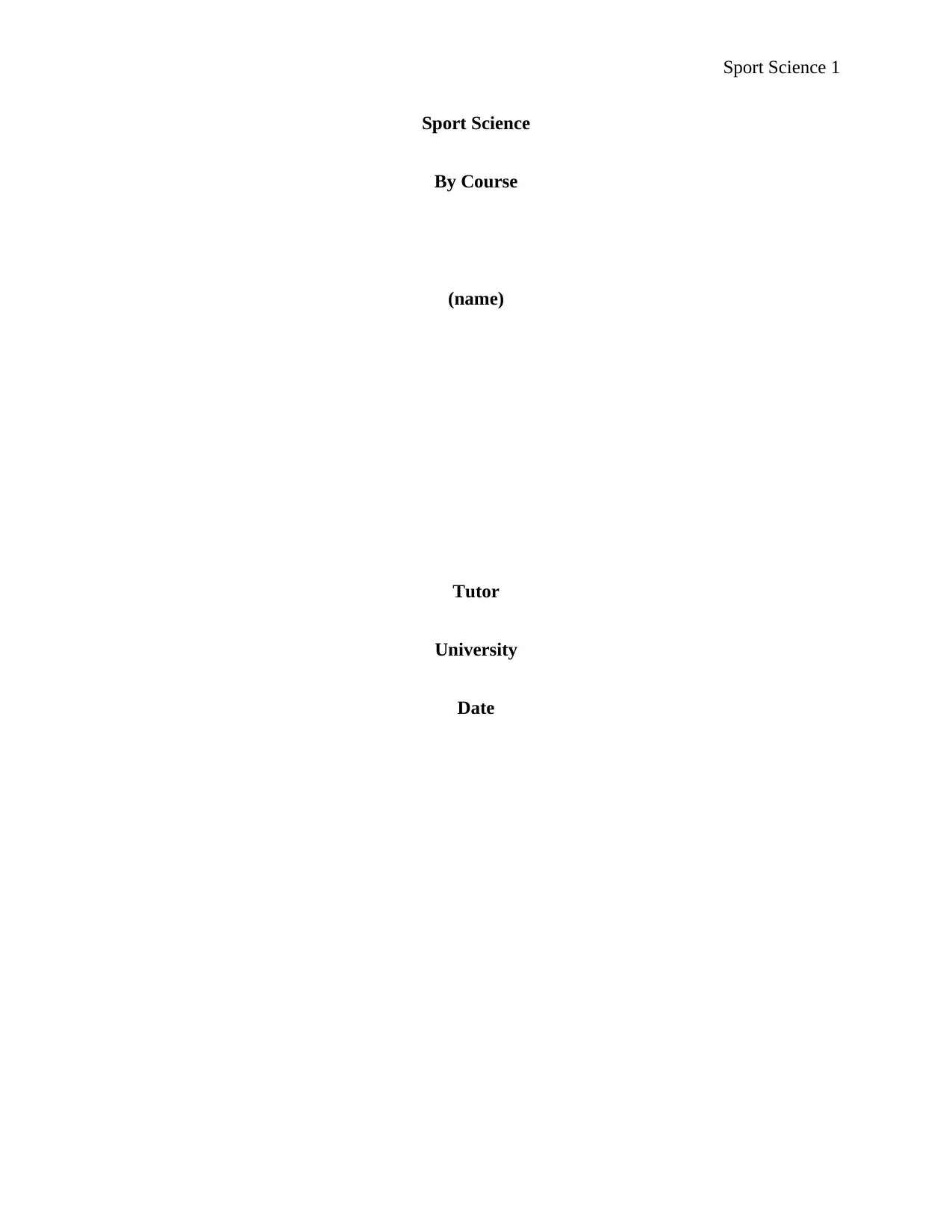
Sport Science 1
Sport Science
By Course
(name)
Tutor
University
Date
Sport Science
By Course
(name)
Tutor
University
Date
Paraphrase This Document
Need a fresh take? Get an instant paraphrase of this document with our AI Paraphraser
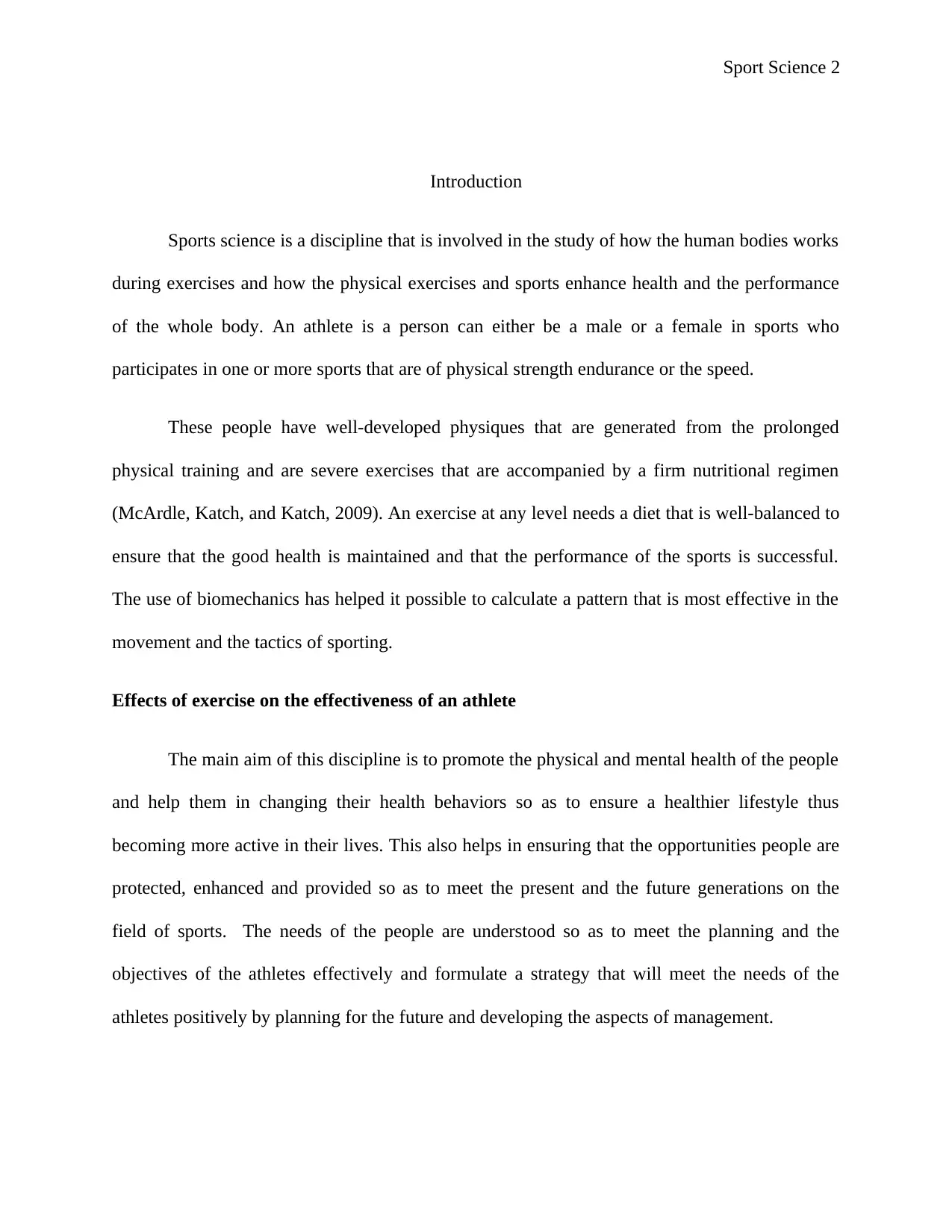
Sport Science 2
Introduction
Sports science is a discipline that is involved in the study of how the human bodies works
during exercises and how the physical exercises and sports enhance health and the performance
of the whole body. An athlete is a person can either be a male or a female in sports who
participates in one or more sports that are of physical strength endurance or the speed.
These people have well-developed physiques that are generated from the prolonged
physical training and are severe exercises that are accompanied by a firm nutritional regimen
(McArdle, Katch, and Katch, 2009). An exercise at any level needs a diet that is well-balanced to
ensure that the good health is maintained and that the performance of the sports is successful.
The use of biomechanics has helped it possible to calculate a pattern that is most effective in the
movement and the tactics of sporting.
Effects of exercise on the effectiveness of an athlete
The main aim of this discipline is to promote the physical and mental health of the people
and help them in changing their health behaviors so as to ensure a healthier lifestyle thus
becoming more active in their lives. This also helps in ensuring that the opportunities people are
protected, enhanced and provided so as to meet the present and the future generations on the
field of sports. The needs of the people are understood so as to meet the planning and the
objectives of the athletes effectively and formulate a strategy that will meet the needs of the
athletes positively by planning for the future and developing the aspects of management.
Introduction
Sports science is a discipline that is involved in the study of how the human bodies works
during exercises and how the physical exercises and sports enhance health and the performance
of the whole body. An athlete is a person can either be a male or a female in sports who
participates in one or more sports that are of physical strength endurance or the speed.
These people have well-developed physiques that are generated from the prolonged
physical training and are severe exercises that are accompanied by a firm nutritional regimen
(McArdle, Katch, and Katch, 2009). An exercise at any level needs a diet that is well-balanced to
ensure that the good health is maintained and that the performance of the sports is successful.
The use of biomechanics has helped it possible to calculate a pattern that is most effective in the
movement and the tactics of sporting.
Effects of exercise on the effectiveness of an athlete
The main aim of this discipline is to promote the physical and mental health of the people
and help them in changing their health behaviors so as to ensure a healthier lifestyle thus
becoming more active in their lives. This also helps in ensuring that the opportunities people are
protected, enhanced and provided so as to meet the present and the future generations on the
field of sports. The needs of the people are understood so as to meet the planning and the
objectives of the athletes effectively and formulate a strategy that will meet the needs of the
athletes positively by planning for the future and developing the aspects of management.
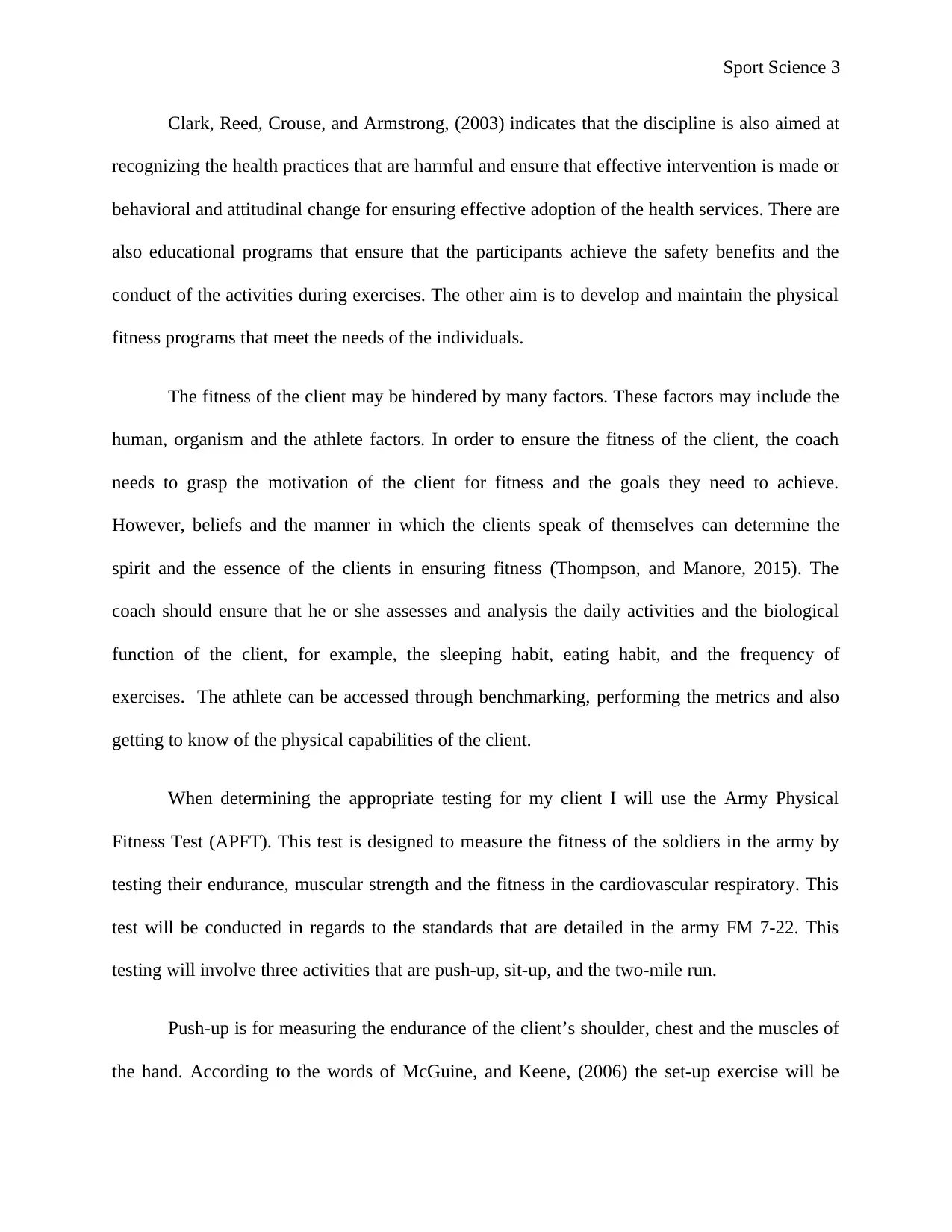
Sport Science 3
Clark, Reed, Crouse, and Armstrong, (2003) indicates that the discipline is also aimed at
recognizing the health practices that are harmful and ensure that effective intervention is made or
behavioral and attitudinal change for ensuring effective adoption of the health services. There are
also educational programs that ensure that the participants achieve the safety benefits and the
conduct of the activities during exercises. The other aim is to develop and maintain the physical
fitness programs that meet the needs of the individuals.
The fitness of the client may be hindered by many factors. These factors may include the
human, organism and the athlete factors. In order to ensure the fitness of the client, the coach
needs to grasp the motivation of the client for fitness and the goals they need to achieve.
However, beliefs and the manner in which the clients speak of themselves can determine the
spirit and the essence of the clients in ensuring fitness (Thompson, and Manore, 2015). The
coach should ensure that he or she assesses and analysis the daily activities and the biological
function of the client, for example, the sleeping habit, eating habit, and the frequency of
exercises. The athlete can be accessed through benchmarking, performing the metrics and also
getting to know of the physical capabilities of the client.
When determining the appropriate testing for my client I will use the Army Physical
Fitness Test (APFT). This test is designed to measure the fitness of the soldiers in the army by
testing their endurance, muscular strength and the fitness in the cardiovascular respiratory. This
test will be conducted in regards to the standards that are detailed in the army FM 7-22. This
testing will involve three activities that are push-up, sit-up, and the two-mile run.
Push-up is for measuring the endurance of the client’s shoulder, chest and the muscles of
the hand. According to the words of McGuine, and Keene, (2006) the set-up exercise will be
Clark, Reed, Crouse, and Armstrong, (2003) indicates that the discipline is also aimed at
recognizing the health practices that are harmful and ensure that effective intervention is made or
behavioral and attitudinal change for ensuring effective adoption of the health services. There are
also educational programs that ensure that the participants achieve the safety benefits and the
conduct of the activities during exercises. The other aim is to develop and maintain the physical
fitness programs that meet the needs of the individuals.
The fitness of the client may be hindered by many factors. These factors may include the
human, organism and the athlete factors. In order to ensure the fitness of the client, the coach
needs to grasp the motivation of the client for fitness and the goals they need to achieve.
However, beliefs and the manner in which the clients speak of themselves can determine the
spirit and the essence of the clients in ensuring fitness (Thompson, and Manore, 2015). The
coach should ensure that he or she assesses and analysis the daily activities and the biological
function of the client, for example, the sleeping habit, eating habit, and the frequency of
exercises. The athlete can be accessed through benchmarking, performing the metrics and also
getting to know of the physical capabilities of the client.
When determining the appropriate testing for my client I will use the Army Physical
Fitness Test (APFT). This test is designed to measure the fitness of the soldiers in the army by
testing their endurance, muscular strength and the fitness in the cardiovascular respiratory. This
test will be conducted in regards to the standards that are detailed in the army FM 7-22. This
testing will involve three activities that are push-up, sit-up, and the two-mile run.
Push-up is for measuring the endurance of the client’s shoulder, chest and the muscles of
the hand. According to the words of McGuine, and Keene, (2006) the set-up exercise will be
⊘ This is a preview!⊘
Do you want full access?
Subscribe today to unlock all pages.

Trusted by 1+ million students worldwide
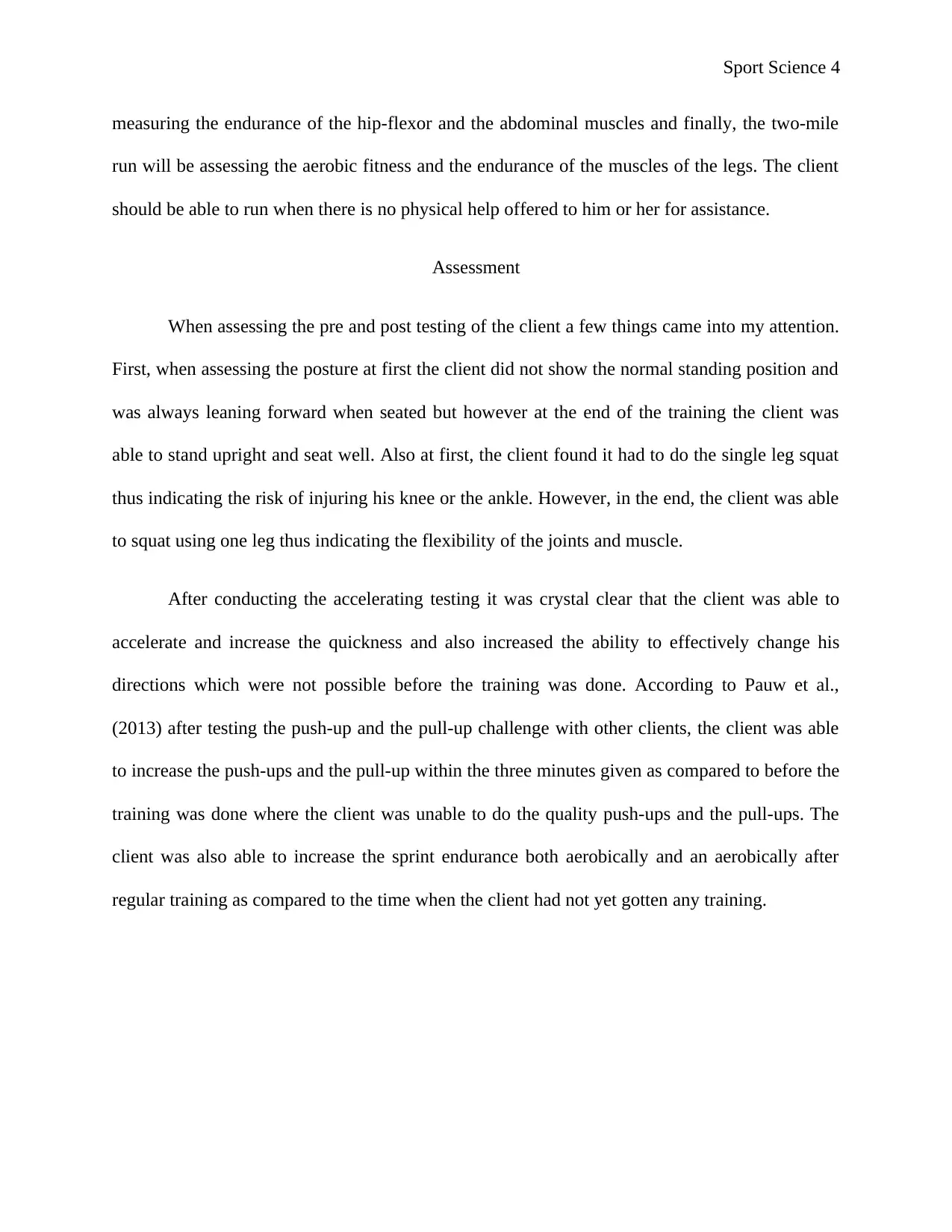
Sport Science 4
measuring the endurance of the hip-flexor and the abdominal muscles and finally, the two-mile
run will be assessing the aerobic fitness and the endurance of the muscles of the legs. The client
should be able to run when there is no physical help offered to him or her for assistance.
Assessment
When assessing the pre and post testing of the client a few things came into my attention.
First, when assessing the posture at first the client did not show the normal standing position and
was always leaning forward when seated but however at the end of the training the client was
able to stand upright and seat well. Also at first, the client found it had to do the single leg squat
thus indicating the risk of injuring his knee or the ankle. However, in the end, the client was able
to squat using one leg thus indicating the flexibility of the joints and muscle.
After conducting the accelerating testing it was crystal clear that the client was able to
accelerate and increase the quickness and also increased the ability to effectively change his
directions which were not possible before the training was done. According to Pauw et al.,
(2013) after testing the push-up and the pull-up challenge with other clients, the client was able
to increase the push-ups and the pull-up within the three minutes given as compared to before the
training was done where the client was unable to do the quality push-ups and the pull-ups. The
client was also able to increase the sprint endurance both aerobically and an aerobically after
regular training as compared to the time when the client had not yet gotten any training.
measuring the endurance of the hip-flexor and the abdominal muscles and finally, the two-mile
run will be assessing the aerobic fitness and the endurance of the muscles of the legs. The client
should be able to run when there is no physical help offered to him or her for assistance.
Assessment
When assessing the pre and post testing of the client a few things came into my attention.
First, when assessing the posture at first the client did not show the normal standing position and
was always leaning forward when seated but however at the end of the training the client was
able to stand upright and seat well. Also at first, the client found it had to do the single leg squat
thus indicating the risk of injuring his knee or the ankle. However, in the end, the client was able
to squat using one leg thus indicating the flexibility of the joints and muscle.
After conducting the accelerating testing it was crystal clear that the client was able to
accelerate and increase the quickness and also increased the ability to effectively change his
directions which were not possible before the training was done. According to Pauw et al.,
(2013) after testing the push-up and the pull-up challenge with other clients, the client was able
to increase the push-ups and the pull-up within the three minutes given as compared to before the
training was done where the client was unable to do the quality push-ups and the pull-ups. The
client was also able to increase the sprint endurance both aerobically and an aerobically after
regular training as compared to the time when the client had not yet gotten any training.
Paraphrase This Document
Need a fresh take? Get an instant paraphrase of this document with our AI Paraphraser
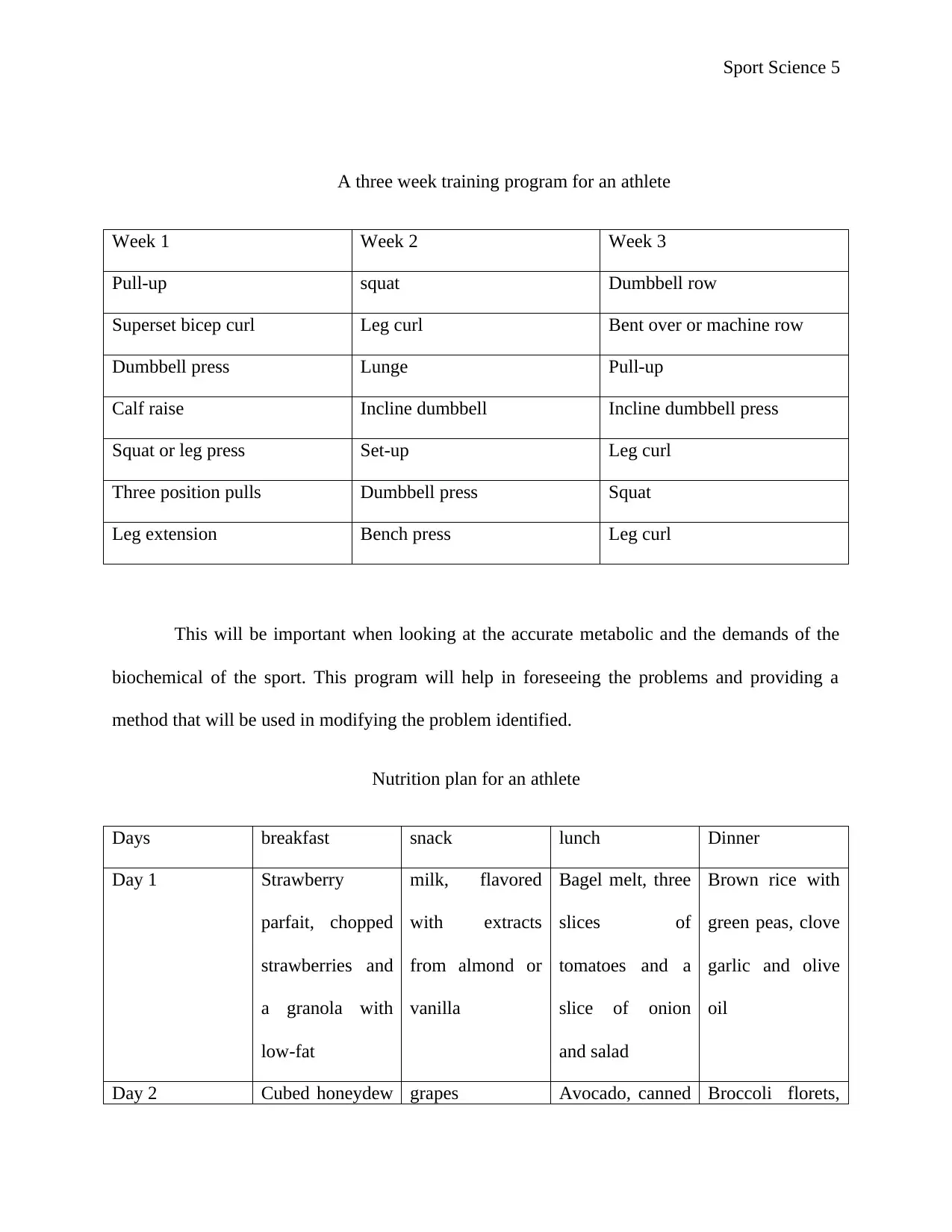
Sport Science 5
A three week training program for an athlete
Week 1 Week 2 Week 3
Pull-up squat Dumbbell row
Superset bicep curl Leg curl Bent over or machine row
Dumbbell press Lunge Pull-up
Calf raise Incline dumbbell Incline dumbbell press
Squat or leg press Set-up Leg curl
Three position pulls Dumbbell press Squat
Leg extension Bench press Leg curl
This will be important when looking at the accurate metabolic and the demands of the
biochemical of the sport. This program will help in foreseeing the problems and providing a
method that will be used in modifying the problem identified.
Nutrition plan for an athlete
Days breakfast snack lunch Dinner
Day 1 Strawberry
parfait, chopped
strawberries and
a granola with
low-fat
milk, flavored
with extracts
from almond or
vanilla
Bagel melt, three
slices of
tomatoes and a
slice of onion
and salad
Brown rice with
green peas, clove
garlic and olive
oil
Day 2 Cubed honeydew grapes Avocado, canned Broccoli florets,
A three week training program for an athlete
Week 1 Week 2 Week 3
Pull-up squat Dumbbell row
Superset bicep curl Leg curl Bent over or machine row
Dumbbell press Lunge Pull-up
Calf raise Incline dumbbell Incline dumbbell press
Squat or leg press Set-up Leg curl
Three position pulls Dumbbell press Squat
Leg extension Bench press Leg curl
This will be important when looking at the accurate metabolic and the demands of the
biochemical of the sport. This program will help in foreseeing the problems and providing a
method that will be used in modifying the problem identified.
Nutrition plan for an athlete
Days breakfast snack lunch Dinner
Day 1 Strawberry
parfait, chopped
strawberries and
a granola with
low-fat
milk, flavored
with extracts
from almond or
vanilla
Bagel melt, three
slices of
tomatoes and a
slice of onion
and salad
Brown rice with
green peas, clove
garlic and olive
oil
Day 2 Cubed honeydew grapes Avocado, canned Broccoli florets,
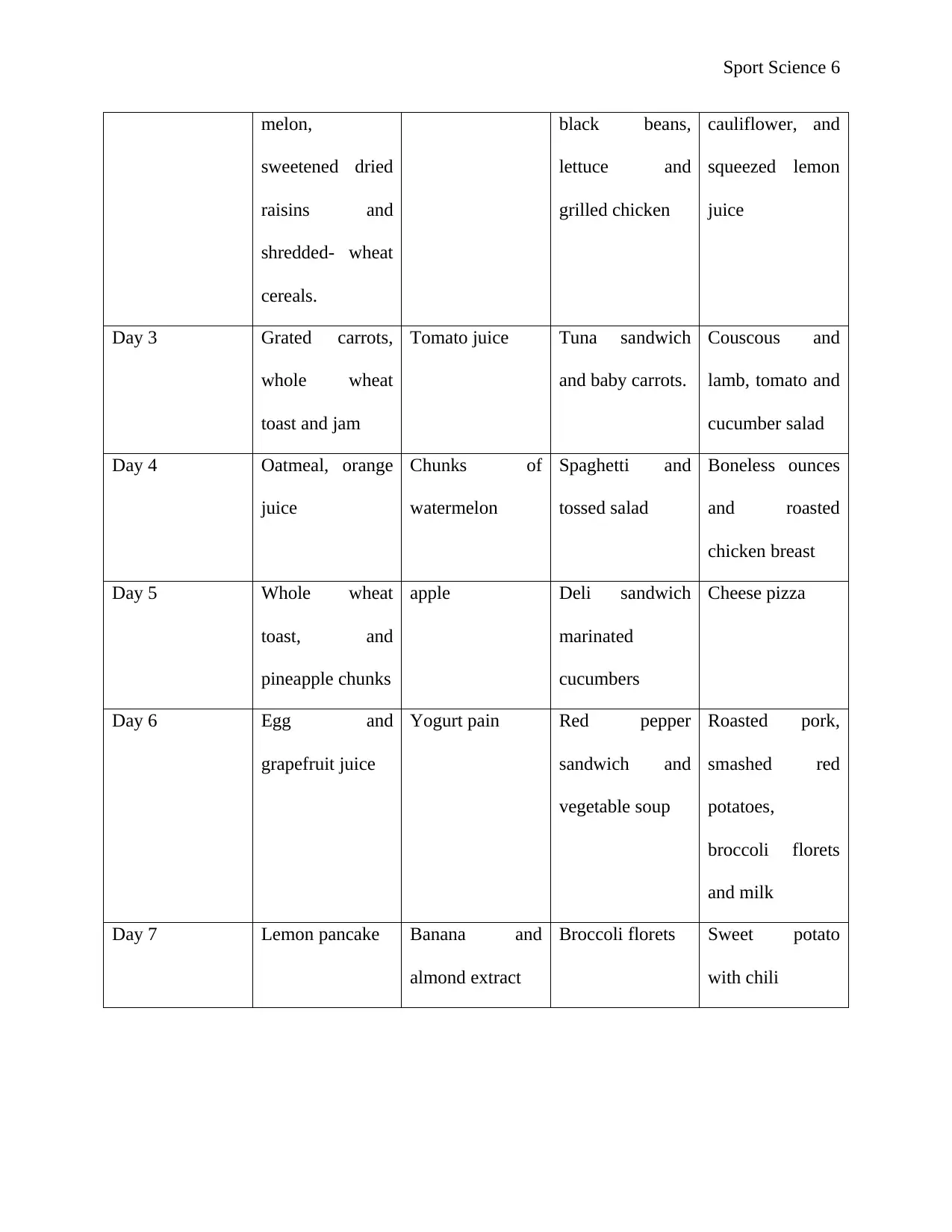
Sport Science 6
melon,
sweetened dried
raisins and
shredded- wheat
cereals.
black beans,
lettuce and
grilled chicken
cauliflower, and
squeezed lemon
juice
Day 3 Grated carrots,
whole wheat
toast and jam
Tomato juice Tuna sandwich
and baby carrots.
Couscous and
lamb, tomato and
cucumber salad
Day 4 Oatmeal, orange
juice
Chunks of
watermelon
Spaghetti and
tossed salad
Boneless ounces
and roasted
chicken breast
Day 5 Whole wheat
toast, and
pineapple chunks
apple Deli sandwich
marinated
cucumbers
Cheese pizza
Day 6 Egg and
grapefruit juice
Yogurt pain Red pepper
sandwich and
vegetable soup
Roasted pork,
smashed red
potatoes,
broccoli florets
and milk
Day 7 Lemon pancake Banana and
almond extract
Broccoli florets Sweet potato
with chili
melon,
sweetened dried
raisins and
shredded- wheat
cereals.
black beans,
lettuce and
grilled chicken
cauliflower, and
squeezed lemon
juice
Day 3 Grated carrots,
whole wheat
toast and jam
Tomato juice Tuna sandwich
and baby carrots.
Couscous and
lamb, tomato and
cucumber salad
Day 4 Oatmeal, orange
juice
Chunks of
watermelon
Spaghetti and
tossed salad
Boneless ounces
and roasted
chicken breast
Day 5 Whole wheat
toast, and
pineapple chunks
apple Deli sandwich
marinated
cucumbers
Cheese pizza
Day 6 Egg and
grapefruit juice
Yogurt pain Red pepper
sandwich and
vegetable soup
Roasted pork,
smashed red
potatoes,
broccoli florets
and milk
Day 7 Lemon pancake Banana and
almond extract
Broccoli florets Sweet potato
with chili
⊘ This is a preview!⊘
Do you want full access?
Subscribe today to unlock all pages.

Trusted by 1+ million students worldwide
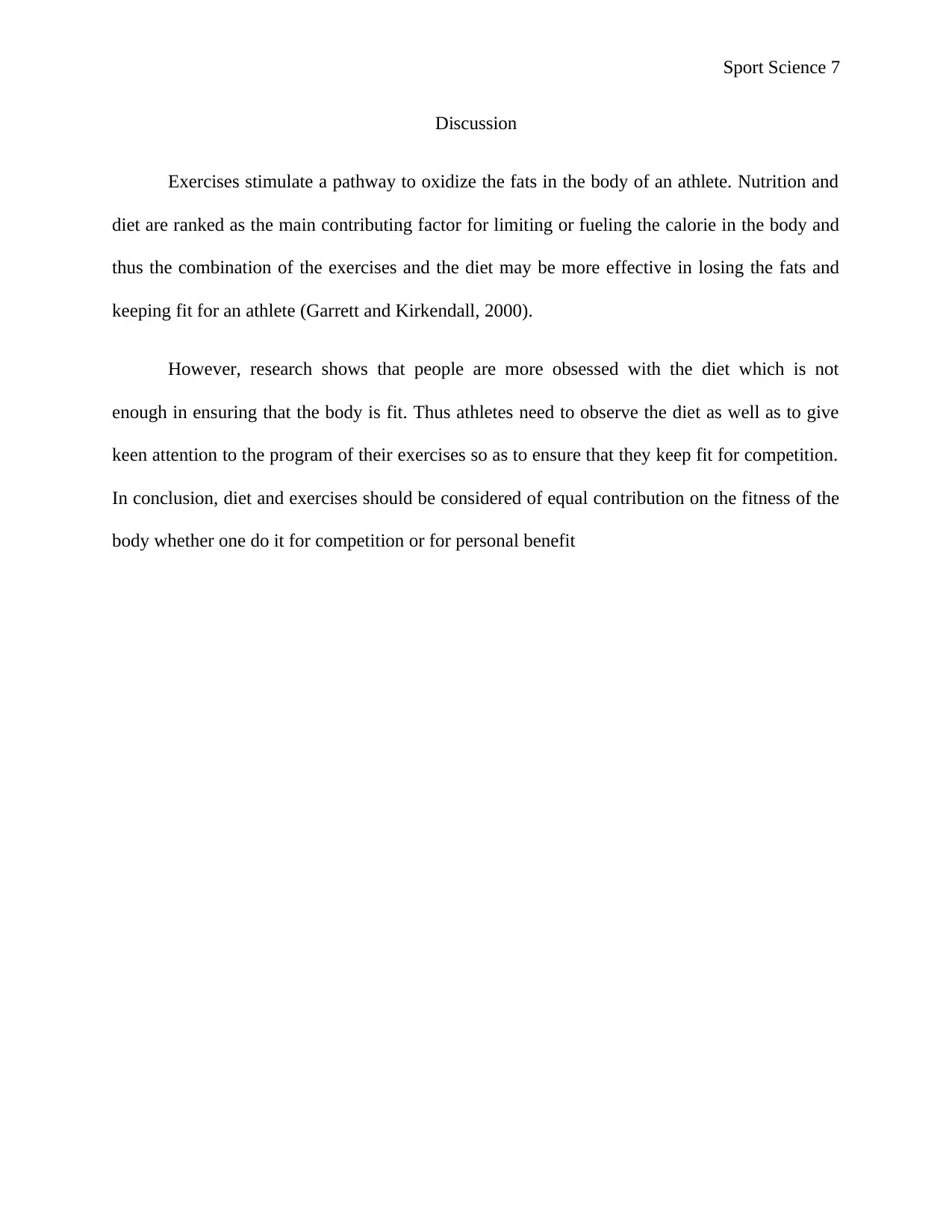
Sport Science 7
Discussion
Exercises stimulate a pathway to oxidize the fats in the body of an athlete. Nutrition and
diet are ranked as the main contributing factor for limiting or fueling the calorie in the body and
thus the combination of the exercises and the diet may be more effective in losing the fats and
keeping fit for an athlete (Garrett and Kirkendall, 2000).
However, research shows that people are more obsessed with the diet which is not
enough in ensuring that the body is fit. Thus athletes need to observe the diet as well as to give
keen attention to the program of their exercises so as to ensure that they keep fit for competition.
In conclusion, diet and exercises should be considered of equal contribution on the fitness of the
body whether one do it for competition or for personal benefit
Discussion
Exercises stimulate a pathway to oxidize the fats in the body of an athlete. Nutrition and
diet are ranked as the main contributing factor for limiting or fueling the calorie in the body and
thus the combination of the exercises and the diet may be more effective in losing the fats and
keeping fit for an athlete (Garrett and Kirkendall, 2000).
However, research shows that people are more obsessed with the diet which is not
enough in ensuring that the body is fit. Thus athletes need to observe the diet as well as to give
keen attention to the program of their exercises so as to ensure that they keep fit for competition.
In conclusion, diet and exercises should be considered of equal contribution on the fitness of the
body whether one do it for competition or for personal benefit
Paraphrase This Document
Need a fresh take? Get an instant paraphrase of this document with our AI Paraphraser
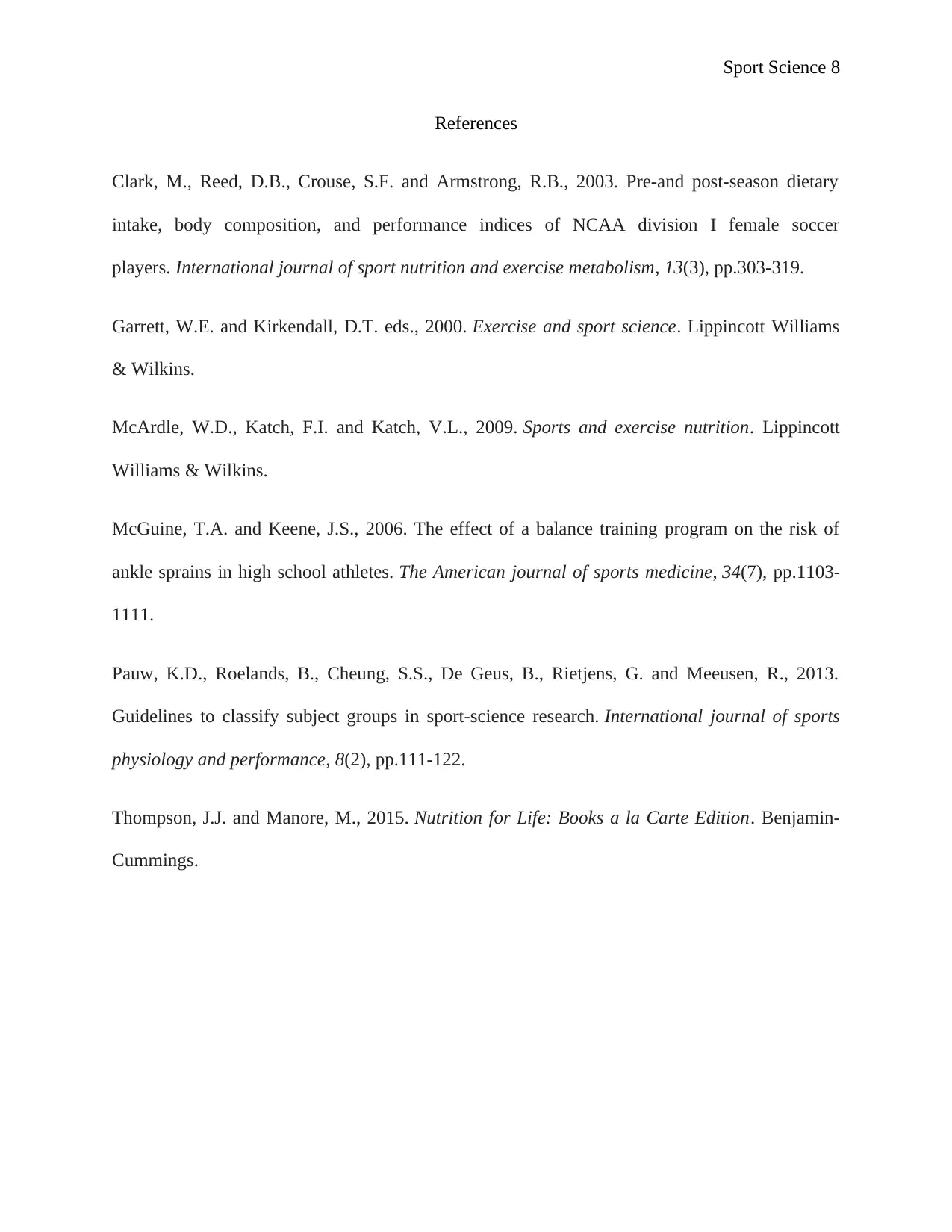
Sport Science 8
References
Clark, M., Reed, D.B., Crouse, S.F. and Armstrong, R.B., 2003. Pre-and post-season dietary
intake, body composition, and performance indices of NCAA division I female soccer
players. International journal of sport nutrition and exercise metabolism, 13(3), pp.303-319.
Garrett, W.E. and Kirkendall, D.T. eds., 2000. Exercise and sport science. Lippincott Williams
& Wilkins.
McArdle, W.D., Katch, F.I. and Katch, V.L., 2009. Sports and exercise nutrition. Lippincott
Williams & Wilkins.
McGuine, T.A. and Keene, J.S., 2006. The effect of a balance training program on the risk of
ankle sprains in high school athletes. The American journal of sports medicine, 34(7), pp.1103-
1111.
Pauw, K.D., Roelands, B., Cheung, S.S., De Geus, B., Rietjens, G. and Meeusen, R., 2013.
Guidelines to classify subject groups in sport-science research. International journal of sports
physiology and performance, 8(2), pp.111-122.
Thompson, J.J. and Manore, M., 2015. Nutrition for Life: Books a la Carte Edition. Benjamin-
Cummings.
References
Clark, M., Reed, D.B., Crouse, S.F. and Armstrong, R.B., 2003. Pre-and post-season dietary
intake, body composition, and performance indices of NCAA division I female soccer
players. International journal of sport nutrition and exercise metabolism, 13(3), pp.303-319.
Garrett, W.E. and Kirkendall, D.T. eds., 2000. Exercise and sport science. Lippincott Williams
& Wilkins.
McArdle, W.D., Katch, F.I. and Katch, V.L., 2009. Sports and exercise nutrition. Lippincott
Williams & Wilkins.
McGuine, T.A. and Keene, J.S., 2006. The effect of a balance training program on the risk of
ankle sprains in high school athletes. The American journal of sports medicine, 34(7), pp.1103-
1111.
Pauw, K.D., Roelands, B., Cheung, S.S., De Geus, B., Rietjens, G. and Meeusen, R., 2013.
Guidelines to classify subject groups in sport-science research. International journal of sports
physiology and performance, 8(2), pp.111-122.
Thompson, J.J. and Manore, M., 2015. Nutrition for Life: Books a la Carte Edition. Benjamin-
Cummings.
1 out of 8
Related Documents
Your All-in-One AI-Powered Toolkit for Academic Success.
+13062052269
info@desklib.com
Available 24*7 on WhatsApp / Email
![[object Object]](/_next/static/media/star-bottom.7253800d.svg)
Unlock your academic potential
Copyright © 2020–2025 A2Z Services. All Rights Reserved. Developed and managed by ZUCOL.





